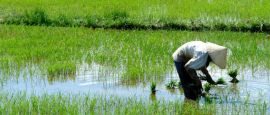Nestled in the mountains of northern Vietnam, Ba Be National Park is centred around a tranquil freshwater lake surrounded by limestone cliffs and dense jungle. It's a haven for nature lovers, offering opportunities for boating, hiking, and visiting remote ethnic minority communities in a peaceful setting far from the usual tourist trail.
Vietnam things to see and do
Remote and largely untouched, the Con Dao Islands offer pristine beaches, coral reefs, and a sombre history. Once home to a notorious prison during French colonial times, the main island now balances historical sites with natural beauty. It's a quiet retreat for those seeking solitude and a connection with Vietnam's past.
A dynamic coastal city in central Vietnam, Da Nang is known for its sandy beaches, modern skyline, and nearby natural wonders. The Marble Mountains, a cluster of limestone and marble hills, are dotted with caves and pagodas, while the striking Dragon Bridge lights up the city each night. Da Nang also serves as a gateway to Hoi An and the imperial city of Hue.
Set in the cool central highlands, Dalat feels worlds away from Vietnam's tropical coast. Known for its pine forests, flower gardens, and French colonial villas, it has long been a favourite retreat. The city's lakes, waterfalls, and quirky attractions, like the surreal Crazy House, make it a refreshing and romantic destination.
A UNESCO World Heritage site, Ha Long Bay is famed for its emerald waters and thousands of limestone islands rising like sentinels from the sea. Visitors can explore the bay on traditional wooden junks, weaving through caves, grottoes, and floating villages. Whether shrouded in mist or glowing under the sun, the bay's otherworldly beauty is unforgettable.
Located in the north, Hanoi is known for its leafy boulevards, lively Old Quarter, and tranquil lakes. Hoan Kiem Lake lies at the city's heart, while landmarks like the Temple of Literature, Ho Chi Minh Mausoleum, and One Pillar Pagoda tell of a rich cultural heritage. The streets hum with activity - motorbikes, markets, and the irresistible aroma of street food. It's a place to wander, sip strong coffee, and watch the layers of history unfold.
Vietnam's largest metropolis pulses with energy. A blend of old and new, it's where colonial architecture rubs shoulders with skyscrapers, and street food stalls compete with trendy cafés. Key sights include the War Remnants Museum, Notre Dame Cathedral, and the bustling Ben Thanh Market. Just outside the city, the Cu Chi Tunnels offer a glimpse into wartime resilience.
Once a bustling trading port, Hoi An is now a beautifully preserved town with yellow-washed houses, winding lanes, and riverside charm. Lantern-lit evenings give the old quarter a magical feel, while tailors, art galleries, and markets add to its appeal. The nearby beaches and ancient ruins of My Son make it an ideal base for exploring central Vietnam.
The former imperial capital, Hue is steeped in history. Located in central Vietnam on the banks of the Perfume River, it sits roughly halfway between Hanoi and Ho Chi Minh City. The moated Citadel houses palaces, temples, and the Forbidden Purple City, recalling the grandeur of the Nguyen emperors. Along the river lie royal tombs, pagodas, and garden houses. It's a city where the past lingers, serene and majestic.
Known as Vietnam's rice bowl, the Mekong Delta is a watery world of canals, floating markets, and fertile landscapes. Life here flows with the river, from bustling trading boats to peaceful villages on stilts. A boat trip offers a chance to witness the delta's rhythms and sample its tropical bounty.
Often dubbed "Ha Long Bay on land", Ninh Binh is a serene landscape of karst peaks, winding rivers, and lush rice paddies. Located just south of Hanoi, it offers boat rides through caves at Tam Coc and Trang An, as well as ancient temples like Bai Dinh and the historic capital of Hoa Lu. It's an idyllic escape into rural Vietnam.
Home to some of the world's largest and most spectacular caves, this park is an adventurer's dream. The colossal Son Doong Cave, the vast Phong Nha Cave, and the shimmering Paradise Cave are highlights. Limestone karsts, underground rivers, and jungle-clad hills complete the dramatic scenery.
Lying off Vietnam's southwest coast in the Gulf of Thailand, Phu Quoc is a tropical paradise of white-sand beaches, palm trees, and crystal-clear waters. Beyond the beaches, visitors can explore dense forests, bustling night markets, and traditional fishing villages. It's perfect for relaxation, snorkelling, and enjoying the island's laid-back charm.
Nestled in the northern highlands, Sapa is a gateway to terraced rice fields, misty mountains, and ethnic minority villages. Trekking through the landscape reveals stunning views and cultural encounters with Hmong, Dao, and Tay communities. The cooler climate offers a refreshing escape from the lowland heat.
Do you have any Feedback about this page?
© 2025 Columbus Travel Media Ltd. All rights reserved. No part of this site may be reproduced without our written permission, click here for information on Columbus Content Solutions.








 You know where
You know where